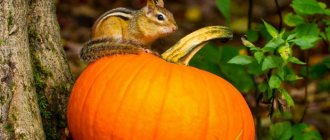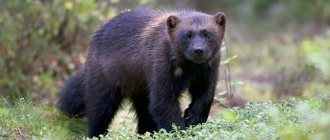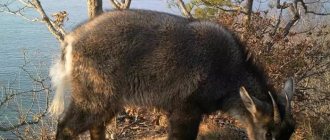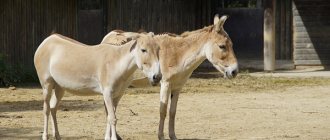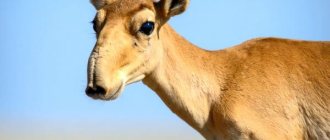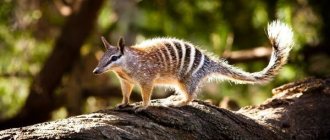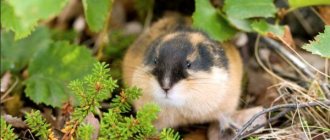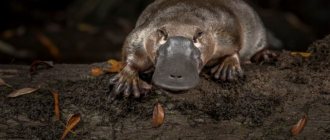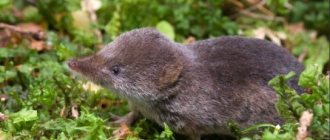Description of the chipmunk
These cute little animals grow up to 15 cm in length. Their tail is up to 10 cm long. Chipmunks weigh about 150 g. The chipmunk differs from its relative the squirrel in color and smaller size.
The fur color of the animal is red. Black stripes stretch along his entire body, starting from his head. Gray-white tones predominate on the abdomen. The main decoration of the chipmunk is its beautiful and lush tail.
Although it is not as fluffy as a squirrel’s, everyone always pays attention to it. The length of the legs is slightly different. The forelimbs are shorter than the hind limbs. Chipmunks are thrifty animals with cheek pouches.
In this way they are similar to gophers and hamsters. They are impossible to notice when they are not filled with anything. But the bags swell noticeably when the animal begins to stuff all sorts of food supplies into them. At such moments, the chipmunk looks even more funny and attractive.
The chipmunk has a pouch behind its cheeks where it can store food in reserve.
The animal's eyes are bulging. This helps him have a wide range of vision. Thanks to their eyes, chipmunks can easily avoid collisions with potential enemies, of which the animal has more than enough in nature. Many birds of prey, ermine, fox, marten are not averse to feasting on this small, fluffy animal.
In nature, there are three main types of chipmunks:
- Asiatic. You can meet it in Siberia, the Urals, the Far East, and northern Russia.
- Eastern American. Its habitat is in North America, in its northeastern part.
- Neotamias. This species of chipmunks also lives in western North America.
All species of chipmunks differ little in appearance and habits. Sometimes, in very rare cases, you can find completely white animals. But they are not albinos. Animals simply have a recessive gene.
The white chipmunk is extremely rare in nature.
Chipmunk Features
Each season has its own animal color. They shed from mid-summer to early autumn. Chipmunks do not have ear tufts like squirrels. They dig holes for themselves to live in. At the same time, they can perfectly move through trees.
An important feature when an animal digs a hole is that they do not put the earth, which becomes redundant, next to their home, but carry it in their cheeks away from their shelter. In this way they try to hide their location from enemies.
A chipmunk's hole is a long shelter in which several chambers are reserved for storing food supplies, one nesting place for the animal to rest, and a couple of dead-end places that the animals use as latrines.
For comfort in their living space, chipmunks cover everything with leaves and grass. It is in these burrows that animals spend the winter. In addition, females also breed their offspring in them. A chipmunk at home is a fairly common occurrence because these cute animals are generally not characterized by aggression.
They can jump perfectly, climb trees, and run on the ground. Chipmunks can overcome any obstacles and barriers in their path. In order to get food for themselves, they can travel incredibly long distances.
They are thrifty. Usually their stockpiles last indefinitely. Moreover, their food is kept in order and completely sorted - in one pile there are seeds, in another there is grass, and in the third there are nuts. Before hibernating, the animal carefully sorts through and dries all these reserves.
At the beginning of winter, the moment comes for the animals when they hibernate. Chipmunks sleep all winter. The awakening of the exhausted animal dates back to March-April. But exhaustion quickly passes, because next to his rest room there is a niche with a whole warehouse of a wide variety of food. Therefore, the animal’s strength and weight are restored very quickly.
These big fidgets almost never sit still. Running through trees and piles of dead wood is a common activity for them. about chipmunks that taking care of them at home is not at all difficult.
The main thing is that the animal feels this painstaking care. Taking care of him and observing his behavior is simply a pleasure, because the chipmunk is not an aggressive animal and communication with him brings only joyful and positive emotions.
One can say about chipmunks that they are big egoists, it’s in their blood. This character trait should be taken into account by people who are just thinking of having them at home. Being zealous guards of their territory, chipmunks are unlikely to tolerate the presence of a large number of their fellows in the same cage. Conflict in such cases is simply inevitable.
There are rumors that the chipmunk is a suicidal animal. They say that they can allegedly hang themselves between two knots when it is discovered that their home is destroyed and there are no more food supplies.
Hunters tell this version. But there is not a single scientific proof of this. Wildlife, together with its inhabitants, is one huge thirst for life.
And it simply cannot be that one small animal will want to commit suicide just because a bear destroyed and robbed its home. Maybe somewhere, once upon a time, someone came across dead chipmunks hanging on a branch, then it was only possible that it was some kind of absurd and pure accident.
Perhaps people came up with such a fable so that future generations would be more careful about living nature, but this version also has no evidence.
This is for me?..
Horses are very smart!
And in your jacket pocket, it seems, there are apples and carrots? This is for me? Thank you very much, I already found it!
The same Schleich company also has an incomparable collection of horses. Exact copies of horses of different breeds, as well as miniature ammunition! And amazing German quality, of course!
Chipmunk Habitat
Taiga animals, chipmunks, prefer forest lawns with tall trees. These are mainly mixed forests. They need thick grass, fallen trees, roots and stumps, among which it is easier to equip themselves with a home.
Woodlands and forest edges, river valleys, cluttered forest areas - these are the places where you can most often find these interesting small animals. In the mountains they can only be found in areas where there are forests. Animals in forests, parks and swampy areas do not like
Each animal builds its own separate home. They may be very close, but none of them will allow their brothers to enter their territory. They prefer to lead a solitary lifestyle, but these solitary settlements sometimes turn into real large colonies.
You can find a lot of them in cereal fields. But it may only seem at first glance that complete chaos and confusion is happening around them. In fact, each chipmunk has its own separate designated territory, beyond the boundaries of which it is undesirable and fraught. Often against this background, fights arise between animals.
Natural enemies
Chipmunks have a lot of enemies. They are hunted by all predatory animals, from wild cats to bears. Babies can also be eaten by birds of prey and snakes. But catching a nimble and agile animal is not so easy. A chipmunk escapes from its pursuers in a tree in dense grass or bushes. When running away, it makes shrill sounds that warn other rodents of danger.
When a person or dog approaches, the chipmunk sits on its hind legs and begins to click and whistle. Usually he allows people to come within 20–30 steps and only then quickly runs away. If a person makes no attempt to catch the animal, then the chipmunk sits on the nearest branch and watches.
Interesting facts about chipmunks
This is not to say that chipmunks are greedy. But they prepare much more food than they need. This simply characterizes them as thrifty animals. Almost all the time since the second half of August, all they do is carry provisions in their cheeks to their bins.
During the long winter hibernation, there are those who experience great hunger and wake up in order to refresh themselves. Chipmunks are active in the morning and evening.
Their emergence from their burrows in the spring occurs in different places at different times. It depends on how the ground warms up above the hole. Where all this happens more intensely, the animals wake up faster accordingly.
Sometimes it happens that weather conditions change for the worse again. The chipmunks have no choice but to hide in their hole again and wait for the weather to improve. If we consider the behavior of autumn and spring chipmunks, there are noticeable differences between them.
Spring ones are characterized by lethargy and inactivity. They prefer to stay close to their burrows and bask in the sun's rays instead of frolicking and running around, as autumn chipmunks do.
In summer they become frisky and lively. They prefer to wait out the peak of the heat in their cool burrows. The chipmunk quickly runs away from its enemies and does not go to its home. Most often, it uses dense bushes or trees for shelter. This is how he leads enemies away from the hole.
Reproduction and lifespan
The rut in animals begins after hibernation. At this time, you can hear something like the whistle of female chipmunks. In this way they let the males know that they are ready to mate.
After mating, pregnancy begins, which lasts about a month and ends with the birth of 3-6 blind and bald babies. The growth of their fur occurs so intensively that after 14 days the little chipmunks have a real and beautiful fur coat.
After 3 weeks, their eyes open. And somewhere around day 120-150, they gradually emerge from their hiding place. Chipmunks reach sexual maturity at 11 months. Animals live for about 10 years.
Elephants are the only animals that have a burial ritual.
Only elephants, humans and Neanderthals have burial rituals.
The average lifespan of an elephant is 60–80 years. If an elephant is sick, members of the herd bring him food and support him in every possible way. If an elephant dies, its loved ones will try to revive it with water and food. When it becomes clear to them that the elephant is dead, the entire herd falls silent...
Often, elephants will dig a shallow grave and cover the dead elephant with mud and branches, then remain near the grave for several days. If any elephant had a very close relationship with the deceased, it may be depressed. A herd that accidentally comes across an unknown, lonely dead elephant will also show a similar attitude towards it.
Elephants have also been known to bury dead people they find in the same manner.
And how should we treat them after that? How to people!
Moreover: the elephant is the only animal that remembers everything!
The best elephant toys
- Choose Schleich elephants!
Elephants are amazing. Get yourself some pet elephants!
The best figures are from the German company Schleich. You can collect a whole family of African and Asian elephants!
For example, a family of African elephants:
elephant
baby elephant
elephant
Nutrition
Basically, plant foods predominate in the animal’s diet. Only occasionally do insects make it onto the menu. Chipmunks are big fans of mushrooms, hazelnuts and pine nuts, acorns, grass, young shoots, buds and seeds of plants, berries, cereals, peas, sunflower seeds, flax, corn and buckwheat.
Sometimes they can eat apricots, plums, and cucumbers. These animals have repeatedly been the main characters in many animated films. A striking example of this is the cartoon " Alvin and the Chipmunks ".
Moreover, these seemingly inconspicuous animals are so popular that the image of a chipmunk can be seen on the coats of arms of some countries and cities, for example Volchansk and Krasnoturinsk.
